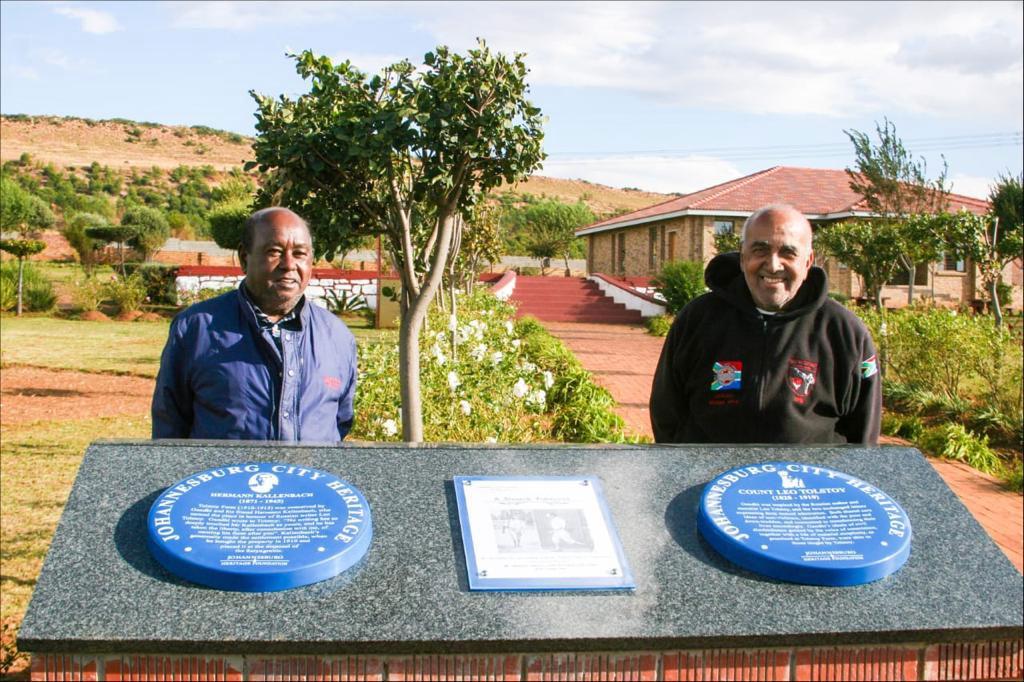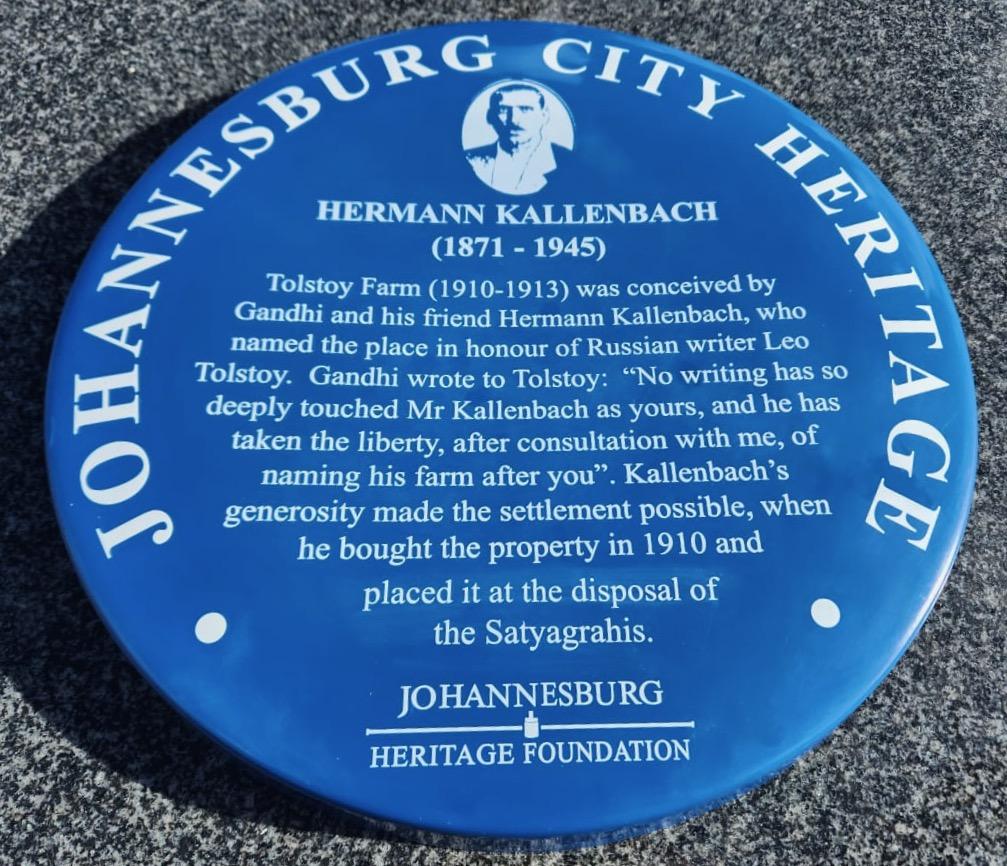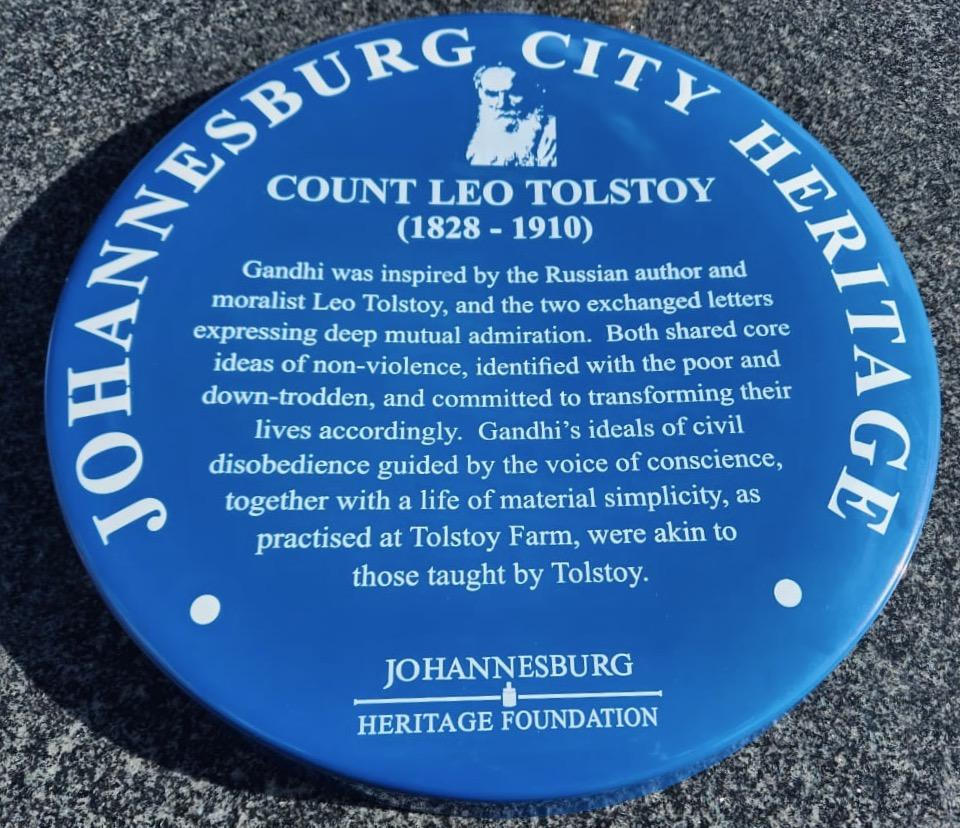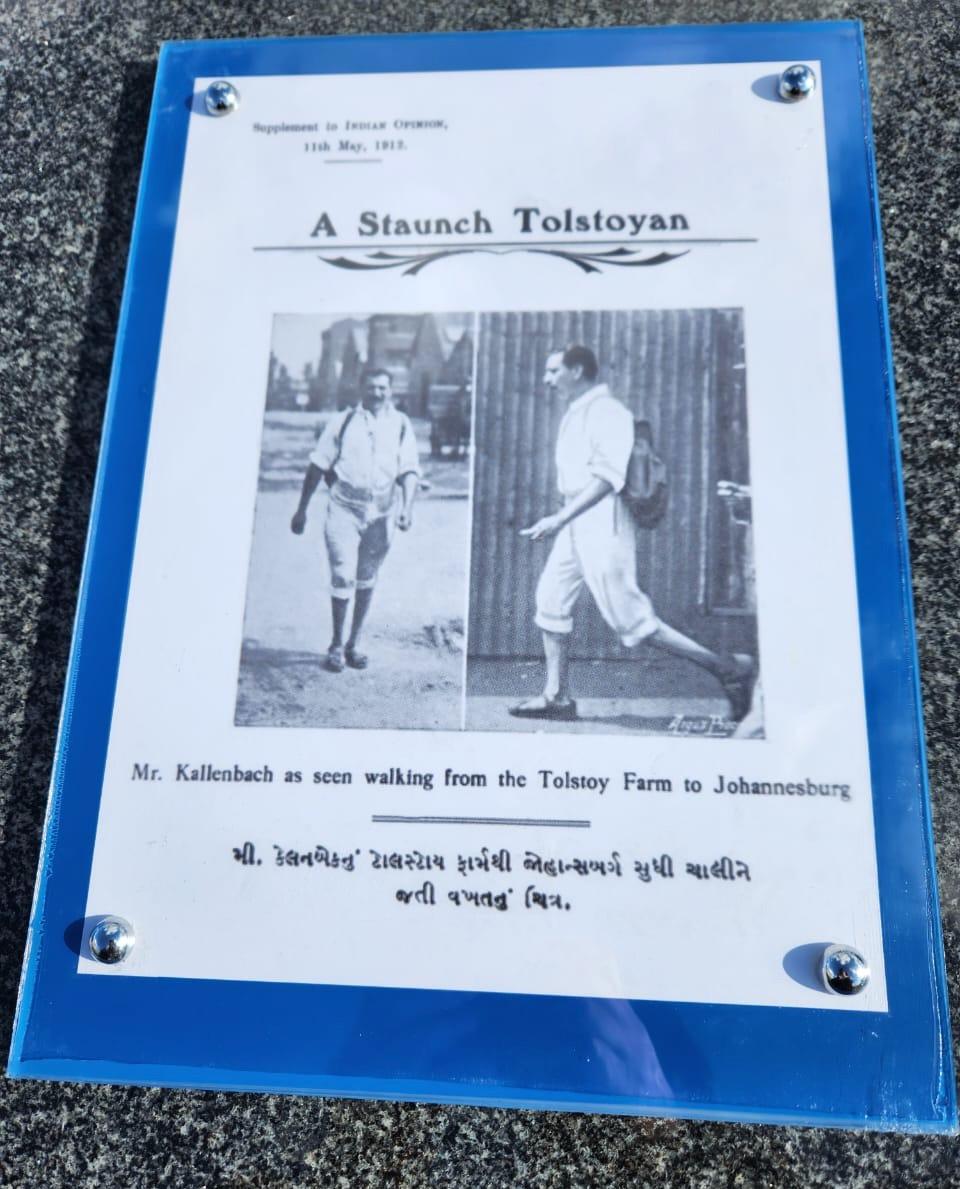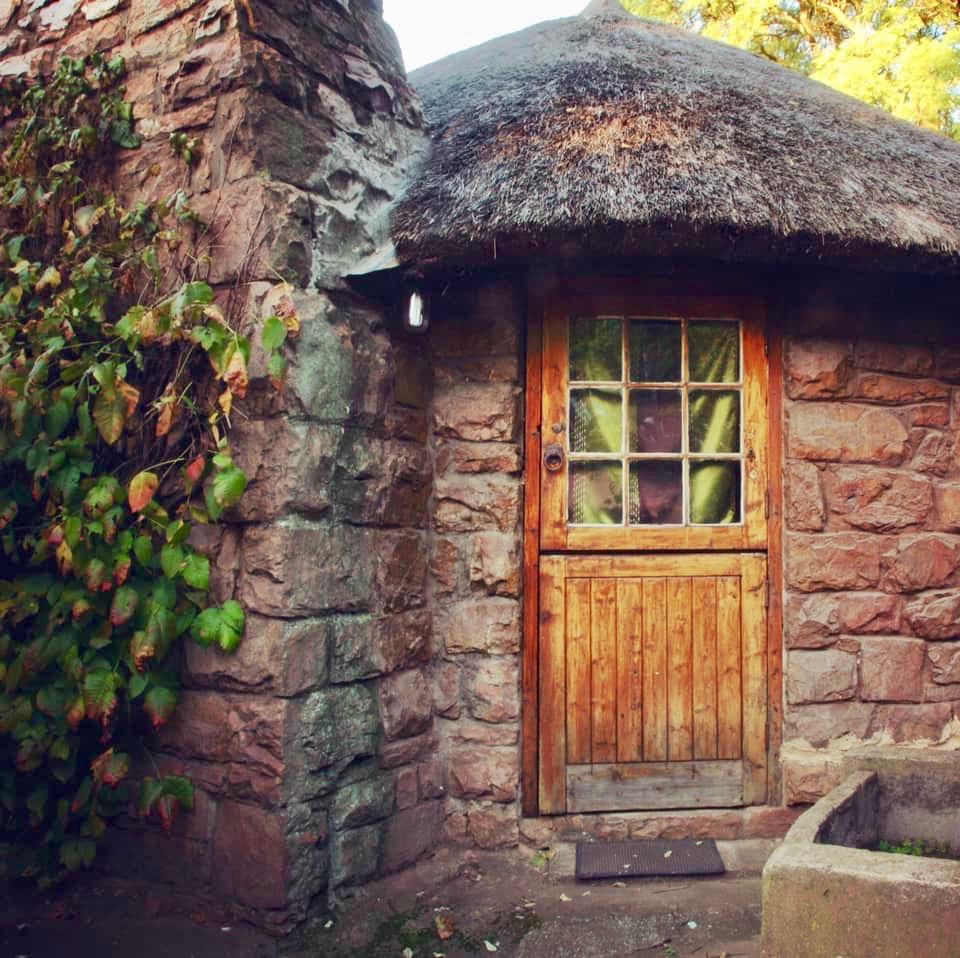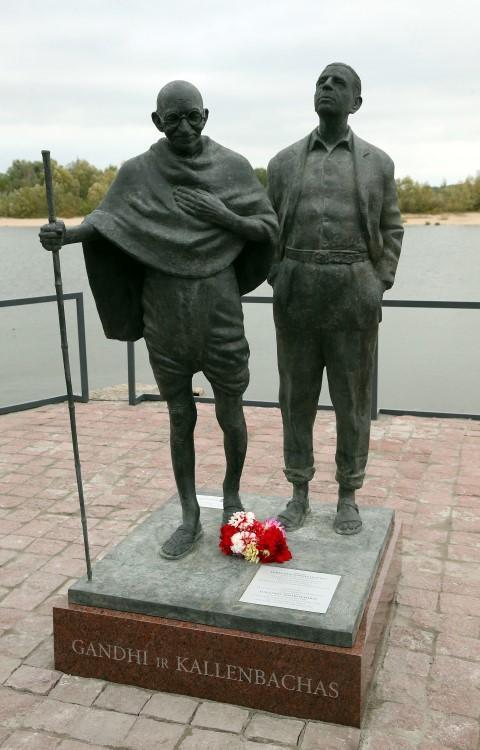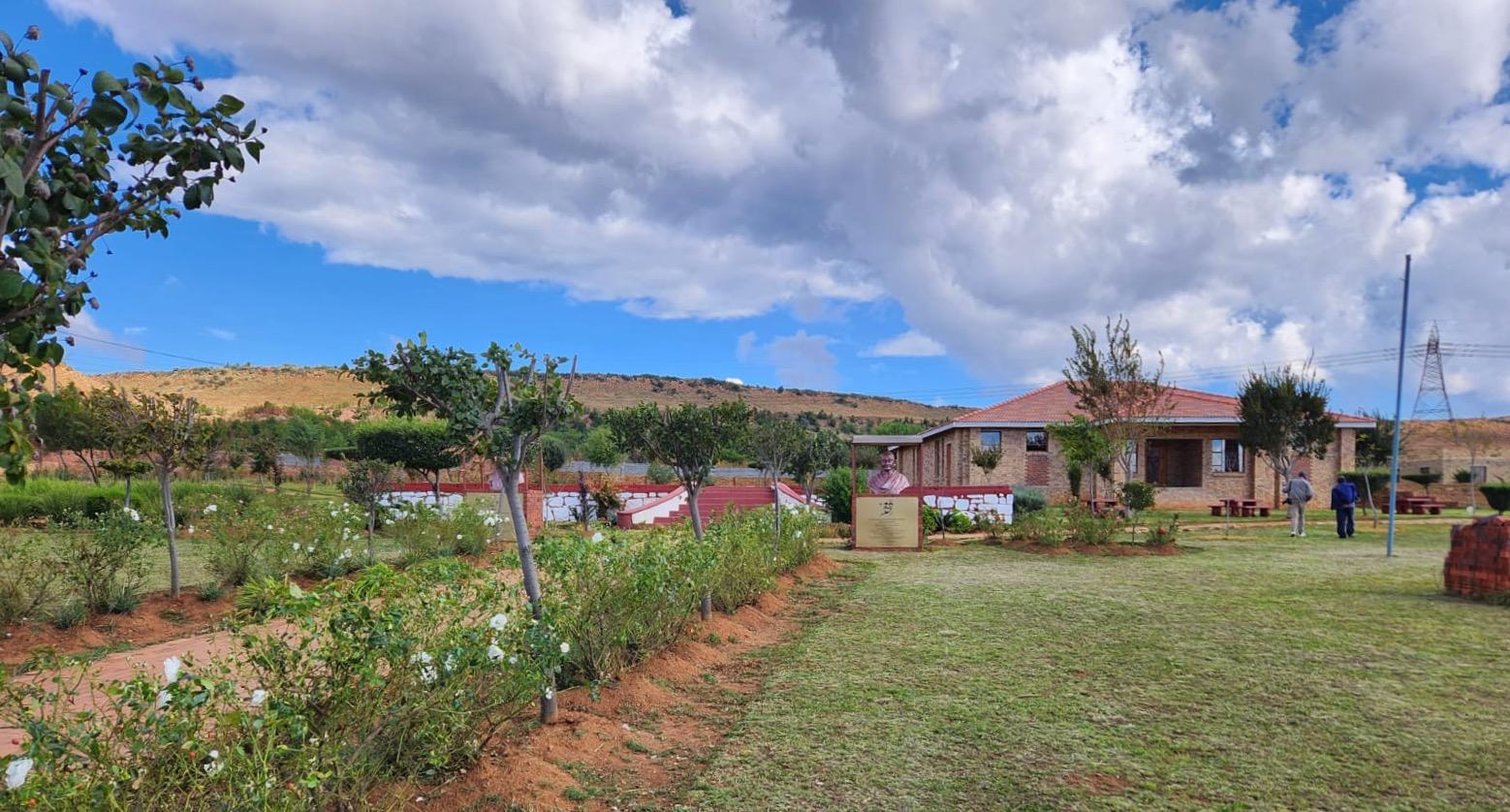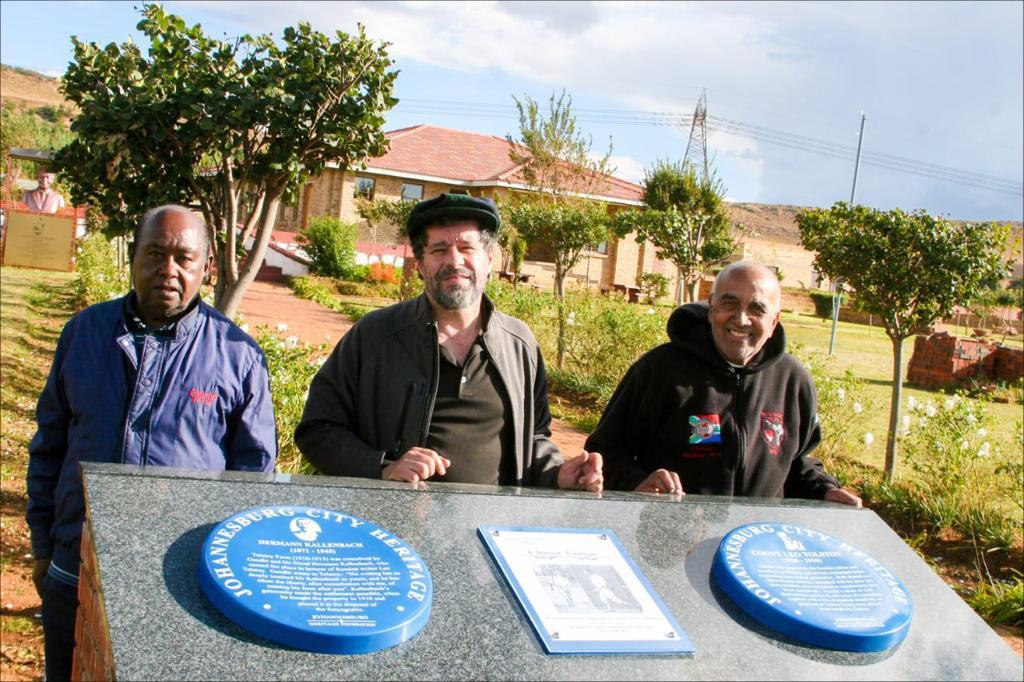
Disclaimer: Any views expressed by individuals and organisations are their own and do not in any way represent the views of The Heritage Portal. If you find any mistakes or historical inaccuracies, please contact the editor.
The Johannesburg Heritage is delighted to announce the installation of two iconic blue plaques at Tolstoy Farm near Lenasia and close to Lawley Station. The plaques have been mounted alongside a poster from Indian Opinion, which was the mouthpiece of Mahatma Gandhi’s Passive Resistance Campaign.
The plaques were installed on 18 May 2023 within the series 'Johannesburg City Heritage' by the City of Johannesburg and the Johannesburg Heritage Foundation.
Installation of the blue plaques
The plaques honour Hermann Kallenbach, the early Johannesburg architect, follower and friend of Mohandas Gandhi, who purchased what we now know as Tolstoy Farm; and the Russian Count Leo Tolstoy, the author of War and Peace and the man who was honoured in the naming of Tolstoy Farm. The connecting link with Tolstoy was in a shared belief in non-violence while taking a stand against injustice, whether in the Tsarist empire or in the Transvaal.
The two blue plaques read as follows:
Hermann Kallenbach (1871-1945)
Tolstoy Farm (1910-1913) was conceived by Gandhi and his friend Hermann Kallenbach, who named the place in honour of Russian writer Leo Tolstoy. Gandhi wrote to Tolstoy: “ No writing has so deeply touched Mr Kallenbach as yours, and he has taken the liberty, after consultation with me, of naming his farm after you”. Kallenbach’s generosity made the settlement possible, when he bought the property in 1910 and placed it at the disposal of the Satyagrahis.
Kallenbach Blue Plaque
Count Leo Tolstoy (1828 - 1910)
Gandhi was inspired by the Russian author and moralist Leo Tolstoy, and the two exchanged letters expressing deep mutual admiration. Both shared core ideas of non-violence, identified with the poor and down-trodden, and committed to transforming their lives accordingly. Gandhi’s ideals of civil disobedience guided by the voice of conscience, together with a life of material simplicity, as practised at Tolstoy Farm, were akin to those taught by Tolstoy.
Tolstoy Plaque
A plinth topped by a granite slab has been erected by the Mahatma Gandhi Remembrance Organisation. The third installation is a reproduction of the iconic page from the Indian Opinion, 1912, with Kallenbach striding out as a staunch Tolstoyan.
Tolstoy Farm is located close to Lawley Station, so that the choice of travel to Johannesburg at that early date was by train or, as Gandhi and Kallenbach preferred, to walk. It was quite a hike, about 35kms (more than 20 miles) over rough veld and early gravel roads. It was about a five hour hike but Kallenbach and Gandhi were fit men - at that stage just touching 40 – 42 years old - and so they strode out in emulation of Tolstoy and the goals of an ascetic lifestyle.
Tolstoy was the Russian writer, progressive thinker and philosopher whose ideas inspired Kallenbach and Gandhi and who corresponded with them prior to his death in 1910. In a letter dated 7th September 1910, Tolstoy wrote to Gandhi: “And so your activity in the Transvaal, as it seems to us, at the end of the world, is the most essential work, the most important of all the work now being done in the world, and in which not only the nations of the Christian, but of all the world will unavoidably take part”.
Kallenbach purchased the farm at Lawley in 1910 and together with Mohandas Gandhi created a community and self-help settlement for the Satyagrahis - the name given to the peaceful followers of Gandhi who become the passive resisters and protestors campaigning for the right for Indians to move freely across provincial boundaries, not to pay a poll tax, the right of a legal marriage and not to carry passes or be finger printed. Satyagrahi families were to come to Tolstoy farm to live, work and recuperate and gather strength for the next phase of the struggle.
Tolstoy farm was the second settlement created by Gandhi, the first being Phoenix north of Durban where he ran his printing press and published Indian Opinion. Phoenix lasted somewhat longer than Tolstoy Farm, but Tolstoy Farm stands out as an extraordinary vision for an alternative community.
The final civil rights campaign in 1913 won concessions from the newly established South African government and Gandhi thought his work in South Africa was complete. It is a complex story of righteous campaign, great sacrifice, seeming success and followed by retreat and heroic failures as progressive causes fought a rear-guard action against segregationist policies of the South African Dominion government followed later by the greater injustice imposed by the apartheid government post 1948.
Both Kallenbach and Gandhi lived at Tolstoy Farm, on the off, between 1910 and 1913. They had to worry about feeding dozens of people, making useful items such as leather sandals, schooling the children, and managing a community of diverse personalities. Gandhi returned to Phoenix early in 1913 and, after a few weeks, Kallenbach returned to live at his Joburg home, The Tents in Mountain View, but made frequent trips by train to connect with Gandhi at Phoenix.
The Tents (Johannesburg Heritage Foundation)
Hermann Kallenbach was the friend and ardent supporter of Gandhi who was ready to leave South Africa with Gandhi and accompany Gandhi and his wife to India to engage in the fight for Indian independence form the British Raj. That hopeful departure from Cape Town in July 1914 unfortunately saw the Gandhi couple and Kallenbach delayed in England by the outbreak of the First World War in August 1914. As a German national, Kallenbach found himself forced to linger in London whilst the Gandhi couple departed for India in December 1914. In 1915 Kallenbach was detained by the British state and sent to a camp for enemy aliens on the Isle of Man and then for a spell at Alexandra Palace camp in London. He only returned to his family in Germany in 1918, and abandoned plans to walk in the footsteps of Gandhi in India.
Kallenbach returned to Johannesburg in 1920 and re-established his architectural practice, partnering with his old business partner, Alexander Kennedy. In 1928 the architectural practice was joined by Stanley Furner, a young English immigrant architect. The three ran the architectural practice of Kallenbach, Kennedy and Furner, perhaps one of the most progressive and innovative of South African architectural enterprises of the interwar period.
Kallenbach only connected with Gandhi again when he travelled to India in 1937. He visited Gandhi again in 1939 and their friendship was resumed. Hermann Kallenbach died at his house in Linksfield in March 1945. Three years later, Gandhi was assassinated in India.
Gandhi and Kallenbach Statue in Lithuania, Kallenbach's country of origin (Martynas Ambrazas)
Today, the memory of Gandhi and Kallenbach at Tolstoy farm is preserved. The farm and surrounding area is owned by a brick company, Corobrick, who have set aside a portion of land for an attractive garden and a museum commemorating the Gandhian settlement. There is a bust of Gandhi on the one side of the steps where an old farmhouse once stood. On the other side of the steps, in an ahistorical associative link, there is a bust of Nelson Mandela, but sadly no memorial to the man who gave substance and reality to Gandhi’s dream of the Tolstoyan settlement, Hermann Kallenbach.
Tolstoy Farm (Eric Itzkin)
With the introduction of the new plaques, we have made a small contribution to publicly acknowledging and celebrating the life and presence of Hermann Kallenbach.
We acknowledge the support from Michael Kallenbach and the Kallenbach family who backed the project from the start; the City of Johannesburg Directorate of Arts Culture and Heritage; the Mahatma Gandhi Remembrance Organization headed by Mohan Hira; and architects Brendan and Yasmin Hart who designed the plinth.
Main image: Eric Itzkin with two members of the Mahatma Gandhi Remembrance Organisation (Jacob Mawela)
Kathy Munro is an Honorary Associate Professor in the School of Architecture and Planning at the University of the Witwatersrand. She enjoyed a long career as an academic and in management at Wits University. She trained as an economic historian. She is an enthusiastic book person and has built her own somewhat eclectic book collection over 40 years. Her interests cover Africana, Johannesburg history, history, art history, travel, business and banking histories. She researches and writes on historical architecture and heritage matters. She is a member of the Board of the Johannesburg Heritage Foundation and is a docent at the Wits Arts Museum. She is currently working on a couple of projects on Johannesburg architects and is researching South African architects, war cemeteries and memorials. Kathy is a member of the online book community the Library thing and recommends this cataloging website and worldwide network as a book lover's haven. She is also the Chairperson of HASA.
Eric Itzkin is the Deputy Director: Immovable Heritage: Directorate of Sports, Arts and Culture at the City of Johannesburg.
Comments will load below. If for any reason none appear click here for some troubleshooting tips. If you would like to post a comment and need instructions click here.

